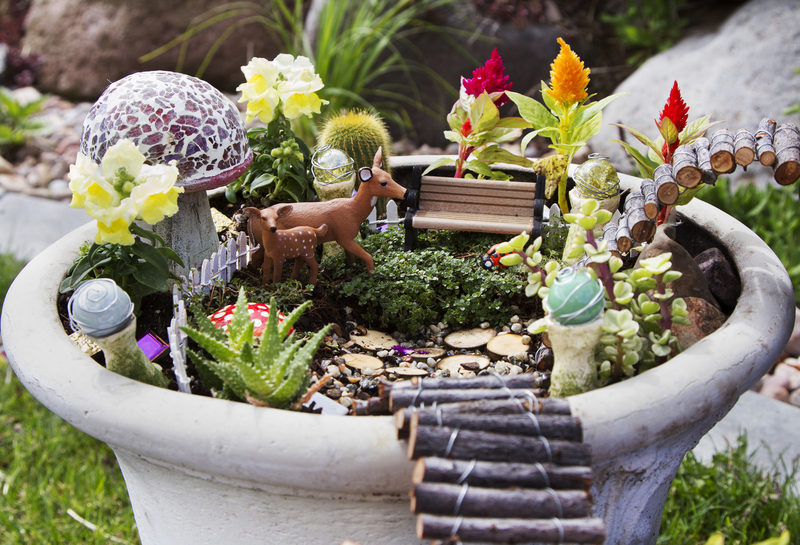Vertical Gardening: The Future of Urban Horticulture
Posted on 28/05/2025
Vertical Gardening: The Future of Urban Horticulture
In today's densely populated cities where green spaces are at a premium, the need for innovative gardening solutions has never been greater. Enter vertical gardening--an ingenious approach to cultivating plants upward rather than outward. This form of urban horticulture is fast becoming the centerpiece of sustainable living and environmental enhancement in metropolitan areas worldwide. This comprehensive guide delves into the many facets of vertical gardening, exploring its benefits, methodologies, and transformative impact on urban environments.
What is Vertical Gardening?
At its core, vertical gardening involves growing vegetation on vertically suspended panels, trellises, or specially designed structures, rather than traditional horizontal plots. This innovative gardening method enables individuals, businesses, and municipalities to maximize their usable growing space--often making greenery possible even where ground area is scarce.
Also referred to as living walls, green walls, or vertical green systems, these gardens can be constructed both indoors and outdoors, lending aesthetic and environmental benefits to rooftops, balconies, building facades, and even interior spaces. In the broader context of urban horticulture, vertical gardening stands out for its space-saving ingenuity and potential to address pressing challenges such as urban heat, air pollution, and food security.

The Rise of Vertical Gardening in Urban Spaces
Over recent years, vertical horticulture has experienced explosive growth in cities around the globe. As urban density increases and available land diminishes, communities and city planners are turning to vertical planting techniques as a practical means to introduce greenery into limited spaces. These living walls now grace office towers, apartment balconies, schoolyards, public buildings, and commercial centers.
Key Factors Driving Urban Vertical Gardening
- Limited Space: Urban gardens often face severe spatial constraints--vertical systems maximize output with minimal ground area.
- Environmental Concerns: Increasing awareness of urban heat, pollution, and climate change has fueled the demand for more vegetation in cities.
- Technological Innovation: Advances in modular planters, drip irrigation, and lightweight soil alternatives have made vertical gardens more accessible.
- Desire for Fresh Produce: Consumers are increasingly interested in locally grown, organic food--vertical gardens can supply vegetables, herbs, and fruits year-round.
Types of Vertical Gardening Systems
Not all vertical gardens are created equal. There are several popular systems--each suited to different needs, structures, and budgets:
1. Living Walls
Living walls, also known as green walls, are composed of panels of plants grown vertically using hydroponic or soil-based technologies. These are often found adorning the sides of commercial buildings and in public spaces. Many feature integrated irrigation and fertilization systems, allowing for lush, diverse plant matrices in any climate.
2. Vertical Planters and Pocket Gardens
Ideal for home gardeners and small spaces, vertical planters use pockets, stacked pots, or tiered assemblies to support plants on a vertical axis. Materials range from felt and fabric wall pocket systems to repurposed pallets and modular plastic planters.
3. Trellis and Espalier Systems
For climbing and vining plants, trellises and espalier techniques allow controlled, upward plant growth. These classic methods are ideal for growing grapevines, tomatoes, peas, and ornamental climbers in confined urban environments.
4. Tower Gardens and Vertical Hydroponics
Tower gardens are free-standing vertical structures engineered primarily for hydroponic (soil-less) cultivation. These systems are particularly effective for growing leafy greens, strawberries, lettuce, and basil in parks, patios, or even indoors.
Benefits of Vertical Gardening for Urban Horticulture
From revitalizing neglected urban corners to supplying fresh produce, the advantages of vertical planting go well beyond aesthetics. Here's a closer look:
Space Efficiency
- Vertical systems utilize unused vertical surfaces such as walls, fences, and building exteriors.
- Enable high-density cultivation in areas with limited land availability.
Enhanced Air Quality
- Green walls help filter airborne pollutants and dust, improving city air.
- Plants increase O2 and reduce CO2 concentrations indoors and outdoors.
Urban Cooling and Energy Efficiency
- Vegetated surfaces absorb less heat, helping to lower the urban heat island effect.
- Vertical green systems act as insulation, reducing heating and cooling costs for buildings.
Noise Reduction
- Plants in vertical gardens absorb sound, making urban spaces quieter and more pleasant.
Food Security and Local Produce
- Enables city dwellers to grow their own vegetables, fruits, and herbs in otherwise unused spaces.
- Reduces reliance on food transported from rural areas, lowering carbon emissions.
Improved Mental Health and Well-being
- Exposure to greenery, even in vertical form, reduces stress and promotes relaxation.
- Community gardens and green installations foster social connection and pride.
Popular Plants for Vertical Gardens
One of the beauties of vertical gardening is the vast range of plants that can thrive in these systems. Plant selection largely depends on climate, light levels, and the structure of your garden. Below are common options used for vertical gardens:
- Leafy Greens: Lettuce, spinach, kale, arugula, chard
- Herbs: Basil, mint, oregano, thyme, chives, coriander, parsley
- Vining Vegetables: Tomatoes, cucumbers, peas, beans
- Strawberries and Small Fruits: Strawberries, dwarf blueberries
- Ornamentals: Ferns, ivies, philodendron, pothos, succulents
- Flowering Plants: Petunias, begonias, pansies, nasturtiums
How to Start a Vertical Garden in Urban Spaces
Setting up a vertical garden--whether on a balcony, rooftop, or interior wall--requires some planning and preparation. Here's a step-by-step guide for urban dwellers eager to embark on their vertical gardening journey:
1. Assess Your Space
Identify suitable walls, railings, or freestanding surfaces. Consider exposure to sunlight (full, partial, or shade), available water sources, and proximity to power (if using grow lights or automatic irrigation).
2. Choose the Right System
Decide between living walls, pocket planters, hydroponic towers, or simple trellis systems based on your space, skills, and goals.
3. Select Appropriate Plants
Pick plants that are compatible with your climate, light levels, and the vertical structure of your garden. Start with easy-to-grow species if you are a beginner.
4. Prepare Your Infrastructure
- Install wall mounts, racks, or grid frames on the selected surface.
- Ensure the structure can bear the weight of wet soil and mature plants.
- Set up irrigation systems--drip or automated watering is highly recommended for larger installations.
5. Plant and Maintain
- Arrange plants in pockets, pots, or hydroponic sleeves according to the design.
- Regularly check moisture levels, prune as needed, and replenish nutrients for continuous growth and health.
Vertical Gardening Innovations
The rise of vertical horticulture has ushered in a wave of technological innovations:
- Modular Green Wall Systems: Pre-fabricated panels that can be easily assembled, expanded, and repaired.
- Smart Irrigation: Automated watering based on plant sensors and weather data ensures optimal moisture, saving water and labor.
- Hydroponics and Aeroponics: Soil-less growing mediums enable lighter, cleaner, and more space-efficient gardens--ideal for high-rises and interior spaces.
- Integrated Lighting: LED grow lights enable successful year-round cultivation indoors or in low-light urban environments.
Vertical Farming vs. Vertical Gardening: What's the Difference?
Though often used interchangeably, vertical gardening and vertical farming are not the same. Vertical farming typically refers to large-scale, commercial food production using stacked layers in controlled environments. In contrast, vertical gardening encompasses both small- and medium-scale projects for homes, community spaces, or office buildings and is often as focused on aesthetics and wellbeing as food production.
Vertical gardens can be highly productive, but their aims often include beautification, climate control, air purification, and leisure, alongside edible or ornamental plants.
Challenges and Solutions in Urban Vertical Gardening
While the prospects for vertical gardening are exciting, adoption does face hurdles:
- Cost: Initial installation, especially for automated living walls, can be high. However, DIY and upcycled options are budget-friendly.
- Maintenance: Vertical gardens may require regular watering, feeding, and pruning to prevent plant stress and disease.
- Structural Integrity: Walls and supports must withstand the weight of mature, watered plants--thorough site assessment is crucial.
- Plant Selection: Not all plants are suitable for vertical growth--choose hardy and adaptable species for greater success.
- Water Management: Efficient irrigation and drainage systems are needed to avoid water wastage and root rot.
Most challenges can be mitigated by thorough design, using lightweight growing media, selecting appropriate species, and employing smart irrigation and fertilization systems.
Case Studies: Vertical Gardening Successes in Urban Horticulture
Around the world, major cities are embracing vertical horticulture:
- Singapore: Famous for its iconic "Gardens by the Bay" and widespread adoption of vertical green walls on its high-rise buildings, Singapore is a global leader in vertical garden innovation.
- Paris, France: The Musee du Quai Branly's living wall, designed by botanist Patrick Blanc, is a 200-meter-long showcase of how vertical gardens can transform an urban landscape and improve a city's microclimate.
- New York City: The "Edible Walls" in schools, restaurants, and apartments offer fresh produce and green insulation where traditional gardens are impossible.
- Tokyo, Japan: Many office buildings now use vertical gardens to beat the summer heat, improve air quality, and provide urban sanctuaries for relaxation.
Vertical Gardening and the Future of Sustainable Cities
As cities confront the realities of population growth, resource scarcity, and climate change, vertical gardening will play a pivotal role in shaping more livable, sustainable, and resilient urban spaces. By maximizing green cover, reducing environmental impact, and reconnecting residents with nature, vertical horticulture offers both hope and proven solutions for the future.
- Increased Biodiversity: Vertical gardens attract pollinators, birds, and beneficial insects, naturally enriching urban ecosystems.
- Green Jobs: Rising popularity of living walls creates opportunities for designers, installers, horticulturists, and urban farmers.
- Healthier Lifestyles: Access to fresh, homegrown produce and green spaces improves urban well-being and food literacy.
- Policy and Planning: Forward-thinking urban planners are incorporating green wall requirements into city bylaws and new developments.

Getting Started: Tips for Urban Gardeners
Ready to embrace the vertical gardening revolution? Follow these bonus tips:
- Start small with a vertical herb garden on your balcony or kitchen wall.
- Learn from others: Join online communities, local urban gardening groups, or workshops for advice on setups and plant care.
- Use upcycled materials: Pallets, bottles, old shoe organizers, and even gutters can be repurposed into vertical planters.
- Monitor regularly: Check for pests, nutrient deficiencies, and irrigation issues frequently for lush, healthy growth.
- Experiment with design: Mix edible and ornamental plants for maximum beauty and utility.
Conclusion: Vertical Gardening--A Green Future for Our Cities
Vertical gardening is much more than a passing trend--it's a practical, scalable solution for greening urban spaces, improving city life, and advancing the future of urban horticulture. Whether you are an apartment dweller, policymaker, business owner, or sustainability enthusiast, the vertical garden offers a pathway toward a healthier, more beautiful, and environmentally responsible urban future. As populations grow and landscapes evolve, vertical gardening will increasingly define the green cities of tomorrow.
Now is the time to go vertical--one wall, one balcony, one city at a time.

